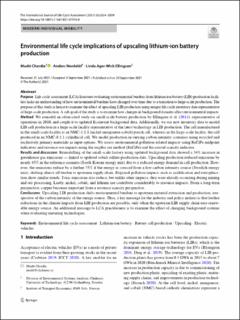| dc.contributor.author | Chordia, Mudit | |
| dc.contributor.author | Nordelöf, Anders | |
| dc.contributor.author | Ellingsen, Linda Ager-Wick | |
| dc.date.accessioned | 2023-06-20T07:44:35Z | |
| dc.date.available | 2023-06-20T07:44:35Z | |
| dc.date.created | 2021-09-29T09:51:31Z | |
| dc.date.issued | 2021-09-23 | |
| dc.identifier.citation | The International Journal of Life Cycle Assessment. 2021, (September), 1-16. | en_US |
| dc.identifier.issn | 0948-3349 | |
| dc.identifier.uri | https://hdl.handle.net/11250/3072206 | |
| dc.description | Chordia, M., Nordelöf, A. & Ellingsen, L.AW. Environmental life cycle implications of upscaling lithium-ion battery production. Int J Life Cycle Assess 26, 2024–2039 (2021). https://doi.org/10.1007/s11367-021-01976-0 | en_US |
| dc.description.abstract | Purpose Life cycle assessment (LCA) literature evaluating environmental burdens from lithium-ion battery (LIB) production facilities lacks an understanding of how environmental burdens have changed over time due to a transition to large-scale production. The purpose of this study is hence to examine the effect of upscaling LIB production using unique life cycle inventory data representative of large-scale production. A sub-goal of the study is to examine how changes in background datasets affect environmental impacts. Method We remodel an often-cited study on small-scale battery production by Ellingsen et al. (2014), representative of operations in 2010, and couple it to updated Ecoinvent background data. Additionally, we use new inventory data to model LIB cell production in a large-scale facility representative of the latest technology in LIB production. The cell manufactured in the small-scale facility is an NMC-1:1:1 (nickel-manganese-cobalt) pouch cell, whereas in the large-scale facility, the cell produced in an NMC-8:1:1 cylindrical cell. We model production in varying carbon intensity scenarios using recycled and exclusively primary materials as input options. We assess environmental pollution–related impacts using ReCiPe midpoint indicators and resource use impacts using the surplus ore method (ReCiPe) and the crustal scarcity indicator. Results and discussion Remodelling of the small-scale factory using updated background data showed a 34% increase in greenhouse gas emissions — linked to updated cobalt sulfate production data. Upscaling production reduced emissions by nearly 45% in the reference scenario (South Korean energy mix) due to a reduced energy demand in cell production. However, the emissions reduce by a further 55% if the energy is sourced from a low-carbon intensity source (Swedish energy mix), shifting almost all burden to upstream supply chain. Regional pollution impacts such as acidification and eutrophication show similar trends. Toxic emissions also reduce, but unlike other impacts, they were already occurring during mining and ore processing. Lastly, nickel, cobalt, and lithium use contribute considerably to resource impacts. From a long-term perspective, copper becomes important from a resource scarcity perspective. Conclusions Upscaling LIB production shifts environmental burdens to upstream material extraction and production, irrespective of the carbon intensity of the energy source. Thus, a key message for the industry and policy makers is that further reductions in the climate impacts from LIB production are possible, only when the upstream LIB supply chain uses renewable energy source. An additional message to LCA practitioners is to examine the effect of changing background systems when evaluating maturing technologies. | en_US |
| dc.language.iso | eng | en_US |
| dc.publisher | Springer | en_US |
| dc.rights | Navngivelse 4.0 Internasjonal | * |
| dc.rights.uri | http://creativecommons.org/licenses/by/4.0/deed.no | * |
| dc.subject | Environmental life cycle assessment | en_US |
| dc.subject | Lithium-ion battery | en_US |
| dc.subject | Battery cell production | en_US |
| dc.subject | Upscaling | en_US |
| dc.subject | Electric vehicles | en_US |
| dc.title | Environmental life cycle implications of upscaling lithium-ion battery production | en_US |
| dc.type | Journal article | en_US |
| dc.type | Peer reviewed | en_US |
| dc.rights.holder | © 2021 The Author(s). | en_US |
| dc.description.version | publishedVersion | en_US |
| cristin.ispublished | true | |
| cristin.fulltext | original | |
| cristin.qualitycode | 2 | |
| dc.identifier.doi | 10.1007/s11367-021-01976-0 | |
| dc.identifier.cristin | 1940269 | |
| dc.source.journal | The International Journal of Life Cycle Assessment | en_US |
| dc.source.volume | 26 | en_US |
| dc.source.issue | September | en_US |
| dc.source.pagenumber | 2024-2039 | en_US |

